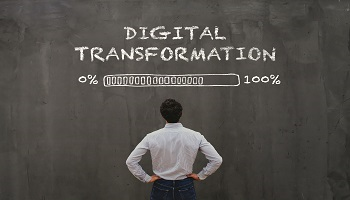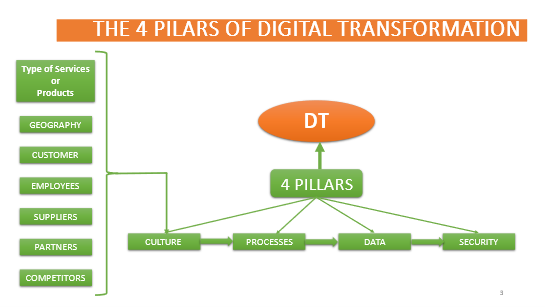
Introduction to the 4 Pillars of Digital Transformation
In the wake of World War I, French Premier Georges Clemenceau advised the French people that “War is too important to be left to the generals”. Paraphrasing his words I would say that “Digital Transformation is too important to be left to the marketing and sales departments”- Why? Because they are infatuated with the client and it is right because it is their main objective and priorities.
While the customer is very important, I will say paramount, I believe the causes of so many pitfalls and failures in the implementation of DT (Digital Transformation) are the obsession of marketing and salespeople on the customer the hyper concentration in the customers disregarding what I believe are the foundation of DT: The Four Pillars of Digital Transformation.
Even before any consideration of the digital part (Software and Hardware) of the DT equation we need to take care of what I call the 4 pillars of Digital Transformation.
- Culture
- Process and Policies
- Data
- Security
They exist in a hierarchical cycle so while some overlapping is possible, the same that when you wear your shoes, you first need to put your socks on. In the four pillars, Culture comes first, then Processes, Data and Security.
Following the diagram of The Four Pillars of Digital Transformation:

Advertisement
For marketing and sales, a customer is an external agent, a person that buys the company’s goods (products and services) for the DT practitioner. The concepts should be broader, instead of customer we should think about USERS.
Please, do not read me wrong. The Sales and Marketing people are paramount for the success of your DT but are not the only ones, in my humble opinion. DT is a matter of life and death for your company and if the CEO and all the C-Level are not deeply involved in the DT projects the probability of success is null, zero, nada.
I am using data as a general term because what we call data is often confused with Information and Knowledge, other two important blocks of the ILC, as I explained in my article “Do we know what are Data, Information and Knowledge?” on this website.
In my other model, “The Intelligence Life Cycle” which I used to discover the AI limitations, I explained what Data, Information and Knowledge really are and created a model of the intelligence Life Cycle based on 4 axioms or postulates in the style of the ancient Greek mathematician Euclid’s. I am going to present the ILC and the Limitations of AI at the PMBA Conference in Orlando next year.
Data is not the New Oil as the hyper propaganda instigated by the media and some data scientists in search of fame, support and money claim, and as you can see from the above diagram, occupied a 3rd position in importance.